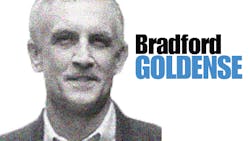Is Engineering Ready to Standardize Innovation?
Innovation has been a front-and center-corporate focus for only about a decade. How can standards for it possibly be set or even be in development just yet? The fact is, innovation has been growing for some time now and is making its way into the corporate mainstream.
“Structured,” “continuous,” and “systematic” innovation have been subjected to corporate tinkering and experimentation for several decades. Edward DeBono’s first book, The Use of Lateral Thinking, for example, was published in 1967. By the 1980s, several large companies had used “Lateral Thinking” techniques. There were enough positive results from the approach that corporations wanted more alternatives. Leading thinkers saw the opportunity to service an emerging market for innovation.
Roger von Oech developed his “Creative Whack Pack” in 1989. This deck of 64 cards in four suits, or four fundamental thinking approaches, also gained corporate traction. There were only a handful more “early providers” in this time frame, but there were enough corporate experiences to make the case that innovation could be improved by external service providers.
Henry Chesbrough published his first work on “open innovation” in 2003. This seminal work opened up the traditional domain of innovation from being an internal-to-the-company initiative to accepting any and all opportunities to improve a company’s innovative capabilities.
When Boston Consulting Group teamed with BusinessWeek in 2004 to annually rank the most innovative firms, companies—and everyone else—could see their market caps rise or fall based on where they fell on the list. So over the next several years, the innovation market took off. It created a critical mass of companies that wanted external tools and influencers to help them hone their innovative capabilities.
Influencers and toolmakers could now make a good living servicing corporate demands. By 2008, GGI identified 275 tools and services available to corporations for improving creativity and innovation (see “Making Product Development Processes More Innovative”). Many of these offerings sprang from brand-new companies, but innovation providers alone couldn’t bring innovation standards to life.
Companies want techniques that work and produce real marketplace value. Companies actively analyze their own experiences and results from new tools and techniques they invest in. Numerous consulting and market research firms have actively studied nearly every aspect of corporate innovation for 10 years now. GGI’s 2008 study became a leading indicator of the tools that are approaching mainstream today. Research by many is starting to show patterns. There is not enough accumulated knowledge yet to determine anything with certainty. But it’s this ongoing and collective rationalization by industry as a whole, evolving since 2004, that has finally opened the doors to developing initial “innovation” standards.
Just last spring, the Product Development & Management Association (PDMA), one of the foremost professional associations for product developers, put the first rail car on the track by announcing its “Innovation Management Framework (IMF).” It has six sections: Culture, Leadership, Resources, Processes, Monitoring & Measuring, and Improvement. The IMF just received its first “industry-wide airing-out” at PDMA’s annual conference this past October.
Professionals involved with innovation should definitely take a minute to internalize what PDMA has put on the table. At the least, there is now a baseline to which you can compare your company, assuming it’s actively trying techniques to improve innovation.
Other practitioners and organizations are working on similar innovation frameworks and standards and they will be made public in the months ahead. It is too early right now, given the still rapidly developing body of knowledge on innovation, to know what the best practices and “final” standards will be. But it is best practice to know what currently exists that engineering departments might be able to use to the benefit of its engineers, product professionals, and company customers.
About the Author
Bradford Goldense
Contributing Technical Expert
Bradford L. Goldense is founder and president of Goldense Group, Inc. [GGI] (www.goldensegroupinc.com), a consulting, market research, and education firm focused on business and technology management strategies and practices for product creation, development, and commercialization. He has been an adjunct faculty member of the graduate engineering school at Tufts University's Gordon Institute for 19 years. Goldense is a Certified New Product Development Professional [NPDP], a Certified Manufacturing Engineer [CMfgE], a Certified Computer Professional [CCP], and is Certified In Production & Inventory Management [CPIM]. He holds over 200 registered copyrights and is a recognized subject-matter expert, including appearances on PBS and CNBC. He has consulted to over 250 companies and over 750 manufacturing locations on four continents since founding GGI in 1986. Goldense holds an MBA in Accounting from the Cornell Johnson School and a BSCE from Brown University. For more information, please see Brad's LinkedIn profile or visit GGI's home page.

